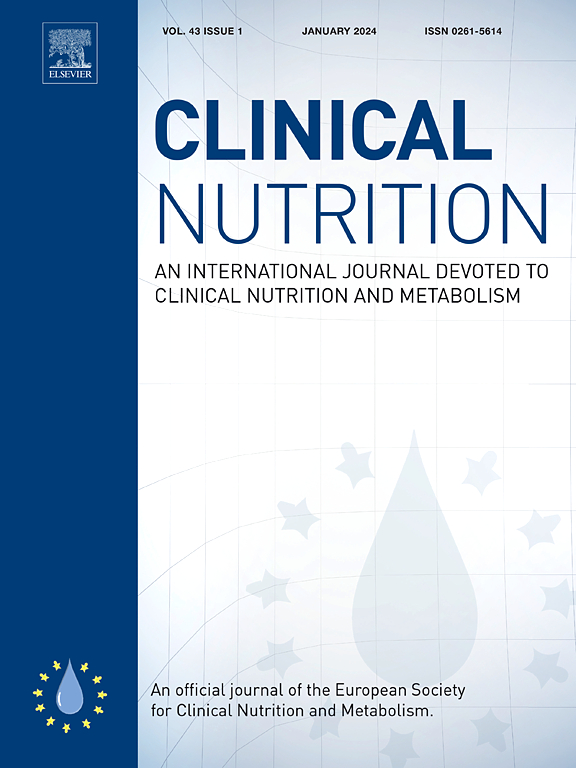适量酒精摄入与肝硬化和脂肪肝风险的关系:一项大型人群队列研究的结果。
IF 6.6
2区 医学
Q1 NUTRITION & DIETETICS
引用次数: 0
摘要
背景与目的:适量饮酒与肝脏相关结果之间的关系尚不确定。我们旨在通过一项大型队列研究探讨适量饮酒与肝硬化、脂肪肝和肝癌之间的关系:方法:共 215 559 名非饮酒者和适量饮酒者(结果:共发现 705 例肝硬化和肝癌患者):中位随访期为 12.7 年,共记录了 705 例肝硬化、2010 例 SLD 和 350 例肝癌病例。与不饮酒者相比,适度饮酒者患 SLD 的风险较低(HR:0.77;95 % CI:0.66,0.89)。在适度饮酒者中,酒精摄入量[每标准差(SD)增量]与发生肝硬化的风险增加有关(HR:1.11;95 % CI:1.02,1.20),但将酒精摄入量限制在每天不超过 16 克后,这种关联性减弱。葡萄酒摄入量(葡萄酒摄入量占酒精总摄入量百分比的每 SD 增量)与肝硬化和 SLD 的发生呈负相关(肝硬化的 HR:0.82;95 % CI:0.75,0.89;SLD 的 HR:0.91;95 % CI:0.87,0.96)。适量饮酒与 SLD 之间的负相关可能与性别有关(交互作用的 P = 0.01):结论:为了肝脏健康,男性每天 30 克的过量酒精阈值可能定得过高。结论:为了肝脏健康,男性每天过量饮酒 30 克的阈值可能定得过高,需要进一步研究,针对不同性别提出适量饮酒促进肝脏健康的建议。本文章由计算机程序翻译,如有差异,请以英文原文为准。
Association of moderate alcohol intake with the risks of cirrhosis and steatotic liver disease: Results from a large population-based cohort study
Background&aims
There is uncertainty about the associations between moderate alcohol consumption and liver-related outcomes. We aimed to explore the associations of moderate drinking with cirrhosis, steatotic liver disease (SLD), and liver cancer in a large cohort study.
Methods
A total of 215,559 non-drinkers and moderate drinkers (<20 g/day alcohol for females or < 30 g/day for males) were enrolled between 2006 and 2010 and followed up to 2022. The primary outcome is incident cirrhosis, and the secondary outcomes are the incidence of steatotic liver disease and liver cancer. Hazard ratios (HRs) and 95 % confidence intervals (CIs) were calculated for liver-related outcomes in relation to moderate drinkers, as well as the quantity and type of their alcohol intake. All analyses were stratified by sex.
Results
A total of 705 cirrhosis, 2010 SLD, and 350 liver cancer cases were documented during a median follow-up period of 12.7 years. Compared with non-drinkers, moderate drinkers had a lower risk of SLD (HR: 0.77; 95 % CI: 0.66, 0.89). Among the moderate drinkers, alcohol intake [per standard deviation (SD) increment] was associated with an increased risk of incident cirrhosis (HR: 1.11; 95 % CI: 1.02, 1.20), but the association was attenuated after restricting alcohol intake to no more than 16 g/day. Wine consumption (per SD increment of the percentage of wine consumption of total alcohol intake) had an inverse association with incident cirrhosis and SLD (HR: 0.82; 95 % CI: 0.75, 0.89 for cirrhosis; HR: 0.91; 95 % CI: 0.87, 0.96 for SLD). The inverse associations between moderate wine use and SLD were likely to be sex-dependent (P for interaction = 0.01).
Conclusions
The excessive alcohol threshold of 30 g/day for males may be set high for liver health. Further work is needed to make sex-specific recommendations on moderate drinking for liver health.
求助全文
通过发布文献求助,成功后即可免费获取论文全文。
去求助
来源期刊

Clinical nutrition
医学-营养学
CiteScore
14.10
自引率
6.30%
发文量
356
审稿时长
28 days
期刊介绍:
Clinical Nutrition, the official journal of ESPEN, The European Society for Clinical Nutrition and Metabolism, is an international journal providing essential scientific information on nutritional and metabolic care and the relationship between nutrition and disease both in the setting of basic science and clinical practice. Published bi-monthly, each issue combines original articles and reviews providing an invaluable reference for any specialist concerned with these fields.
 求助内容:
求助内容: 应助结果提醒方式:
应助结果提醒方式:


